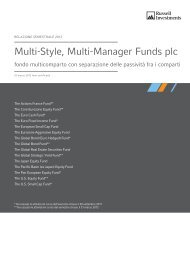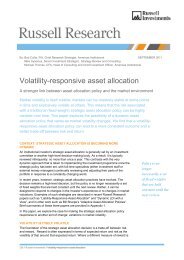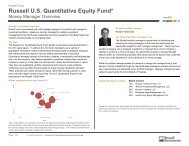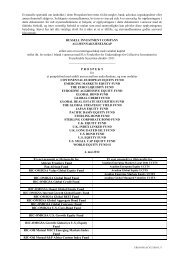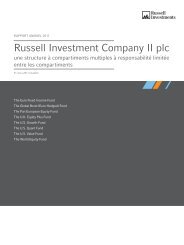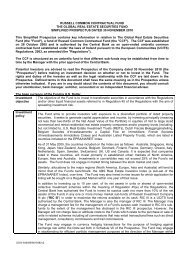Implementing LDI with swaptions - Russell Investments
Implementing LDI with swaptions - Russell Investments
Implementing LDI with swaptions - Russell Investments
Create successful ePaper yourself
Turn your PDF publications into a flip-book with our unique Google optimized e-Paper software.
RUSSELL INVESTMENTS<br />
trade, there are times when market supply<br />
and demand can act in favor of DB plans. 5<br />
Versus historical levels, <strong>swaptions</strong>’ current<br />
levels may be attractive enough to warrant<br />
consideration. 6 Indeed, the consensus<br />
(due to sovereign risk concerns, debt<br />
downgrades, inflation concerns or other<br />
reasons) has been that interest rates will<br />
rise, so most investors have been seeking<br />
protection against this scenario. Pension<br />
plans, on the other hand, which seek<br />
protection from falling interest rates, appear<br />
very much in the minority on the demand<br />
versus supply ledger. The purchase of such<br />
protection is therefore currently (at time<br />
of this writing) cheaper than it has been<br />
historically. Investors should keep in mind<br />
the variability of pricing over time—the<br />
strategy we have described here makes a<br />
lot more sense in certain circumstances than<br />
it does in others.<br />
Conclusion: another instrument<br />
in the <strong>LDI</strong> toolbox<br />
We have seen that <strong>swaptions</strong> can help<br />
to reduce the exposure of a DB plan to<br />
variations in interest rates and thus form<br />
part of an <strong>LDI</strong> program, and that the<br />
conditionality built into <strong>swaptions</strong> can<br />
mirror the design of an LRAA strategy.<br />
On the plus side, <strong>swaptions</strong> offer downside<br />
protection in the case of declines in interest<br />
rates, <strong>with</strong> the price being paid by a cap on<br />
potential gains if rates rise significantly. That<br />
price, however, appears consistent <strong>with</strong> the<br />
directional trend to de-risk as a plan’s funded<br />
status improves. Finally, the attractiveness<br />
of the pricing of these instruments can vary<br />
significantly over time, so there is always a<br />
timing judgment that needs to be exercised<br />
when choosing <strong>swaptions</strong>.<br />
The authors wish<br />
to thank Jim<br />
Simonson for his<br />
excellent research<br />
assistance.<br />
Additional research on liability-driven investing<br />
You can access the following <strong>Russell</strong> research papers on <strong>Russell</strong>.com/institutional<br />
or via ClientLINK at https://clientlink.russell.com:<br />
››<br />
“Positioning <strong>LDI</strong> portfolios in today’s volatile market conditions” by Martin<br />
Jaugietis and Bob Collie<br />
››<br />
“Transitioning to <strong>LDI</strong> strategies” by Travis Bagley and Aran Murphy<br />
››<br />
“<strong>LDI</strong>’s role in pension plan strategy: Risk and return considerations” by Bob<br />
Collie and John Osborn<br />
››<br />
“Liability-responsive asset allocation” by James Gannon and Bob Collie<br />
››<br />
“Does equity have duration? And if so, is it useful for <strong>LDI</strong>?” by James Gannon<br />
6<br />
Based on market prices as<br />
of September 15, 2011.<br />
p / 7





